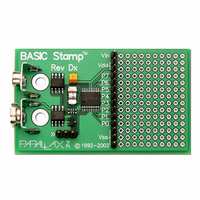27100 Parallax Inc, 27100 Datasheet - Page 13

27100
Manufacturer Part Number
27100
Description
BASIC STAMP REV DX MODULE
Manufacturer
Parallax Inc
Type
Microcontrollerr
Datasheet
1.27100.pdf
(23 pages)
Specifications of 27100
Contents
Board
Product
Microcontroller Basic Stamps
Operating Supply Voltage
5 to 15 V
Board Size
63.5 mm x 38.1 mm x 12.7 mm
For Use With/related Products
BASIC Stamp®
Lead Free Status / RoHS Status
Lead free / RoHS Compliant
Available stocks
Company
Part Number
Manufacturer
Quantity
Price
Part Number:
271000-51300730
Manufacturer:
DENSO
Quantity:
20 000
STAMP FAQS
How do I reprogram the BASIC Stamp?
How big of a program can I store in the BASIC Stamp?
Can I expand the program memory?
Can I expand the data memory?
How difficult is it to program the BASIC Stamp?
Can I program the BASIC Stamp in Visual BASIC or QBASIC?
What is PBASIC?
Can I imbed assembly language routines in my PBASIC code?
Last Revised On: 7/21/00
Simply re-connect it to the computer, run the BASIC Stamp editor and press ALT-R (DOS software) or CTRL-R
(Windows software).
The BASIC Stamp I has 256 bytes of program storage; enough for 80 to 100 lines of PBASIC1 code. The
BASIC Stamp II has 2048 bytes of program storage; enough for 500 to 600 lines of PBASIC2 code. The BASIC
Stamps IIe and IIsx each have 16,384 bytes of program storage separated into 8 pages of 2048 bytes. Each page
(or code section) can hold 500 to 600 lines of PBASIC2e, or PBASIC2sx code, respectively, for an overall total
of approx. 4000 instructions.
No, the program memory is not expandable as the interpreter chip expects the memory to be a specific, fixed size.
Yes, you may interface EEPROMs, or other memory devices, the BASIC Stamp’s I/O pins to gain more data
storage area. You will have to include the appropriate code within your PBASIC program to interface to the
particular device you choose.
When compared to other programmable microcontrollers, the BASIC Stamps are perhaps the easiest to use
because of their simple, but powerful, language structure and straightforward method of downloading and
debugging. If you have some experience programming in BASIC, C or Pascal, you should find the learning process
with the BASIC Stamp to be a simple one. If, however, you have never had any programming experience, you may
have to spend some extra time studying the examples and application notes before you feel comfortable with the
BASIC Stamp.
No. The BASIC Stamp is a microcontroller, not a miniature PC. It does not have a graphical user interface, a hard
drive or a lot of RAM. The BASIC Stamp must only be programmed with PBASIC, which has been specifically
designed to exploit all of the BASIC Stamp’s capabilities.
PBASIC (Parallax BASIC) is a hybrid form of the BASIC programming language in which many people are
familiar. Currently there are three versions of PBASIC: PBASIC1 for the BASIC Stamp I, PBASIC2 for the
BASIC Stamp II and PBASIC2sx for the BASIC Stamp IIsx. Each version is specifically tailored to take
advantage of the inherent features of the hardware it runs on. PBASIC is called a hybrid because, while it contains
some simplified forms of standard BASIC commands, it also has special commands to efficiently control the I/O
pins.
No. The BASIC Stamp is a PBASIC interpreter only and cannot except assembly language routines.
PROGRAMMING INFORMATION
Page: 13





















